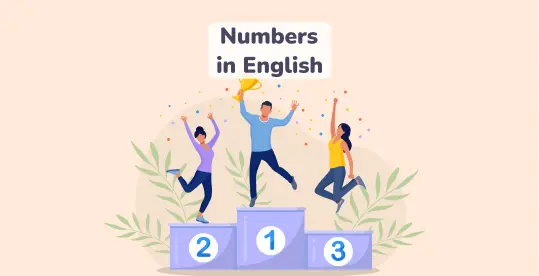Numbers list in English (0–100)
The basic numbers are divided into several categories: ones, teens and tens. Look at this picture to browse all of them:

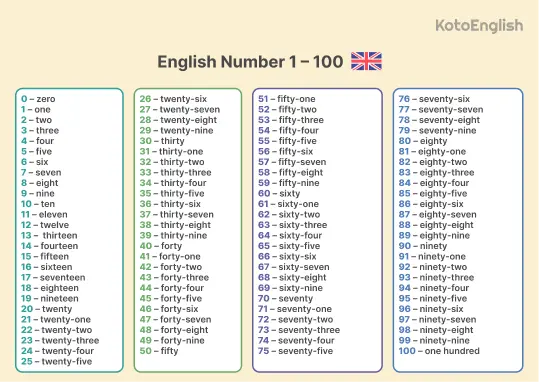
Basic English numbers 0–20
Numbers 0-10
You set off your number journey at this point — learning from 0 to 10. Read these examples to know how to spell numbers in English, listen to how they are pronounced, and repeat them to improve your pronunciation.
| Digit | Word | Example |
|---|---|---|
| 0 |
zero
|
I have
|
| 1 |
one
|
My Netflix plan is for
|
| 2 |
two
|
I drink
|
| 3 |
three
|
You have
|
| 4 |
four
|
We need tickets for
|
| 5 |
five
|
Give me
|
| 6 |
six
|
There are
|
| 7 |
seven
|
Take
|
| 8 |
eight
|
The Harry Potter movie has
|
| 9 |
nine
|
My sister goes to bed at
|
| 10 |
ten
|
The closest Target is
|
Each number in English follows simple rules. You don’t need to change their form based on gender or other characteristics.
From 11-20
From thirteen to nineteen, words have the same ending — teen. You can easily memorize them by connecting them to the word teenager. Eleven and twelve are unique words that correspond to the digits 11 and 12.
| Digit | Word | Example |
|---|---|---|
| 11 |
eleven
|
|
| 12 |
twelve
|
There are
|
| 13 |
thirteen
|
I liked the first
|
| 14 |
fourteen
|
We’ll spend
|
| 15 |
fifteen
|
The cheapest Ryanair tickets cost
|
| 16 |
sixteen
|
When you are
|
| 17 |
seventeen
|
I have
|
| 18 |
eighteen
|
You can vote when you are
|
| 19 |
nineteen
|
In
|
| 20 |
twenty
|
One episode of Friends lasts
|
Pay attention to the stress. It typically falls on the second part of the word: eighTEEN, not EIGHteen.
Level up your English with Koto!
Numbers from 20 to 100
The pattern from tens is simple; you only need to memorize their forms, which are similar to ones. A typical ending, -ty, helps the words quickly fix in your mind.
Tens
Learners often make mistakes with forty and fifty, because they are spelled in a different way than four and five.
| Digits | Words | Examples |
|---|---|---|
| 20 |
twenty
|
She has
|
| 30 |
thirty
|
There are
|
| 40 |
forty
|
They collected
|
| 50 |
fifty
|
Do you have
|
| 60 |
sixty
|
We will be there in
|
| 70 |
seventy
|
There are
|
| 80 |
eighty
|
The team has
|
| 90 |
ninety
|
Why did you buy
|
| 100 |
a hundred / one hundred
|
There are
|
The figures from 21 to 99 should be written with a hyphen (-) between two digits, so it looks like this: Twenty-one, twenty-two not twenty one, twenty two.
Having covered numbers 1 to 100, let’s move on to larger figures.
Counting from 100 and beyond
Large figures are divided into several categories. Read the full list to understand how to write numbers in English when they have so many digits.

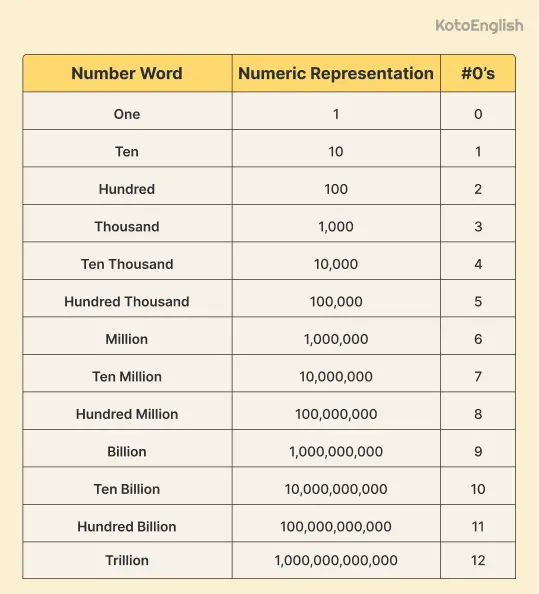
Hundreds
You will use the word hundred in any combination of numbers, from 100 to 999.
The number 100 can be spelled as a hundred or one hundred. Both variations are correct, but one hundred is more formal. As you can see, it requires an article or the number one. You don’t just use the bare word as in other languages.
- 200 =
two hundred - 300 =
three hundred - 400 =
four hundred
The same rule applies to larger numbers, including thousands, millions, billions, etc.
Thousands and millions
Everything that goes after 999 to 999,999 will require you to use the word thousand.
- 2,000 =
two thousand - 10,000 =
ten thousand - 100,000 =
one hundred thousand - 999,999 =
nine hundred thousand nine hundred ninety-nine
In informal speech, natives of the UK and the USA sometimes say fifteen hundred instead of one thousand and five hundred.
The word million, used to describe a 1,000,000 digit, acts similarly to the words hundred and thousand.
- 1,000,000 =
one million - 10,000,000 =
ten million - 10,000,000 =
one hundred million
Consider that creating phrases with the word dollar requires a singular verb that follows a number in English: A million dollars is a big sum of money. When numbers are coupled with any other nouns (people, flowers, watches), the verb is plural: A million books are sold by our story every year.
Types of numbers in English grammar
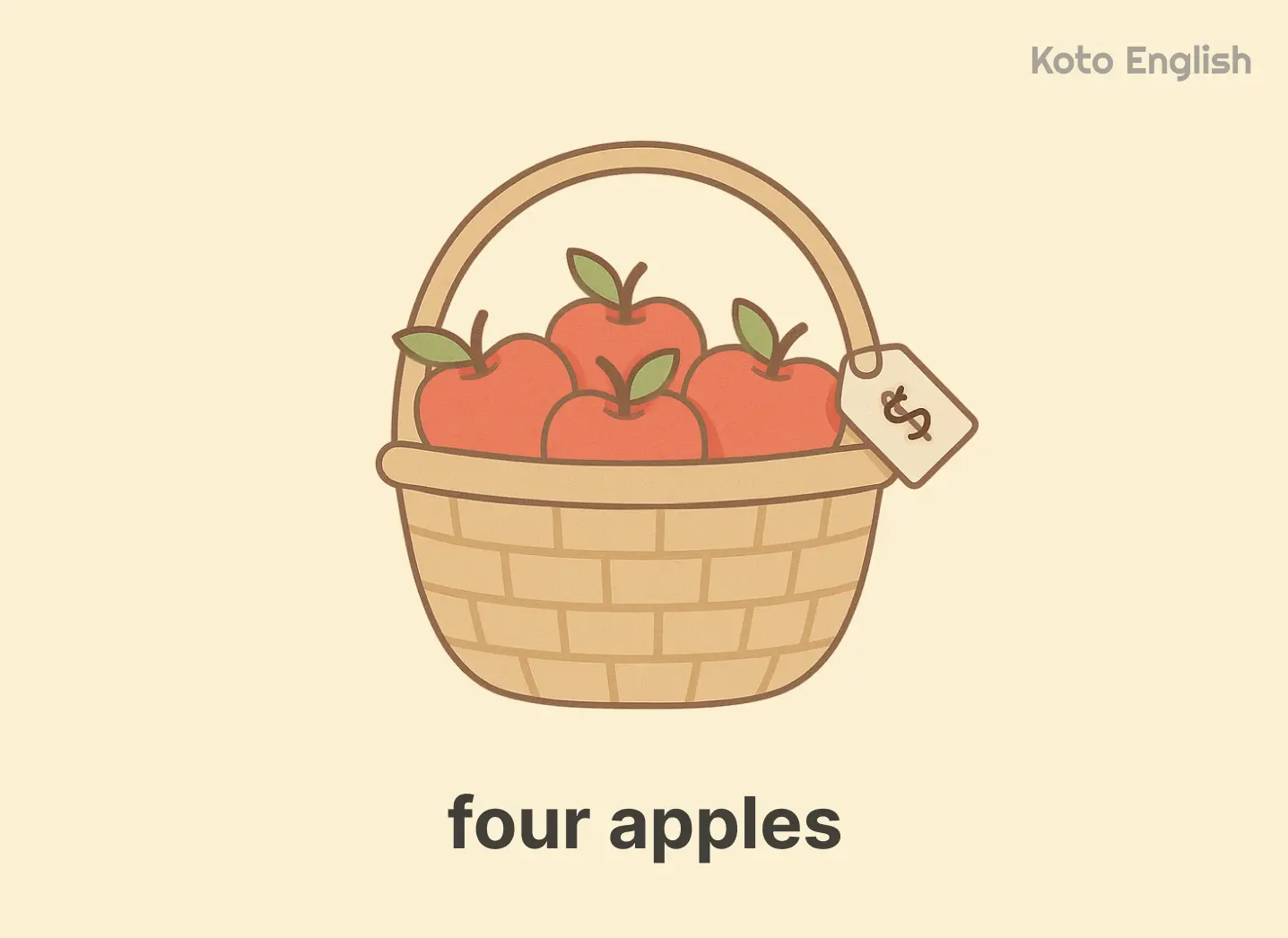
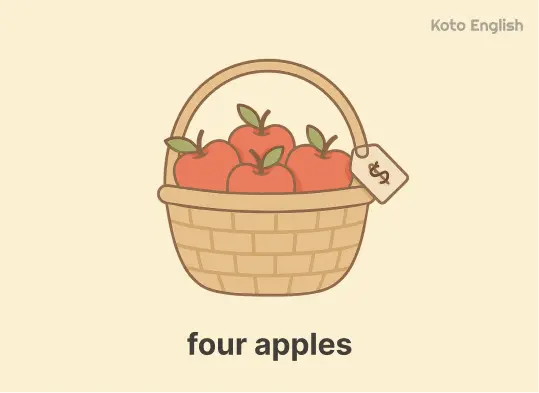
The numbers we outlined above cannot be used in all possible numerical expressions, as there are different types: cardinal, ordinal, fractions, and decimals, and this list is not exhaustive. Continue reading to learn the grammar specifics of their usage
Cardinal numbers
You use cardinal English numbers when going to the shop and asking how much something costs or checking how many work hours are left for the day.
The following rules apply to them:
-
They don’t require the article the unless it is something specific:
The family went to Rome forseven days. — Not specific days.Theseven days we spent in Brazil were special. — Specific days, the days in Brazil. -
With a meaning before 11, use numbers in words in English. After 11, write numbers, especially if you write about millions, billions, and so on:
I drankthree glasses of milk.The deadline to complete this project is25 days.
Use this category when writing decimals and percentages.
Ordinal numbers
This type of number is very common in English. You use it to talk about the order of things and events, including:
- dates;
- instructions:
- orders;
- floors, buildings, streets.
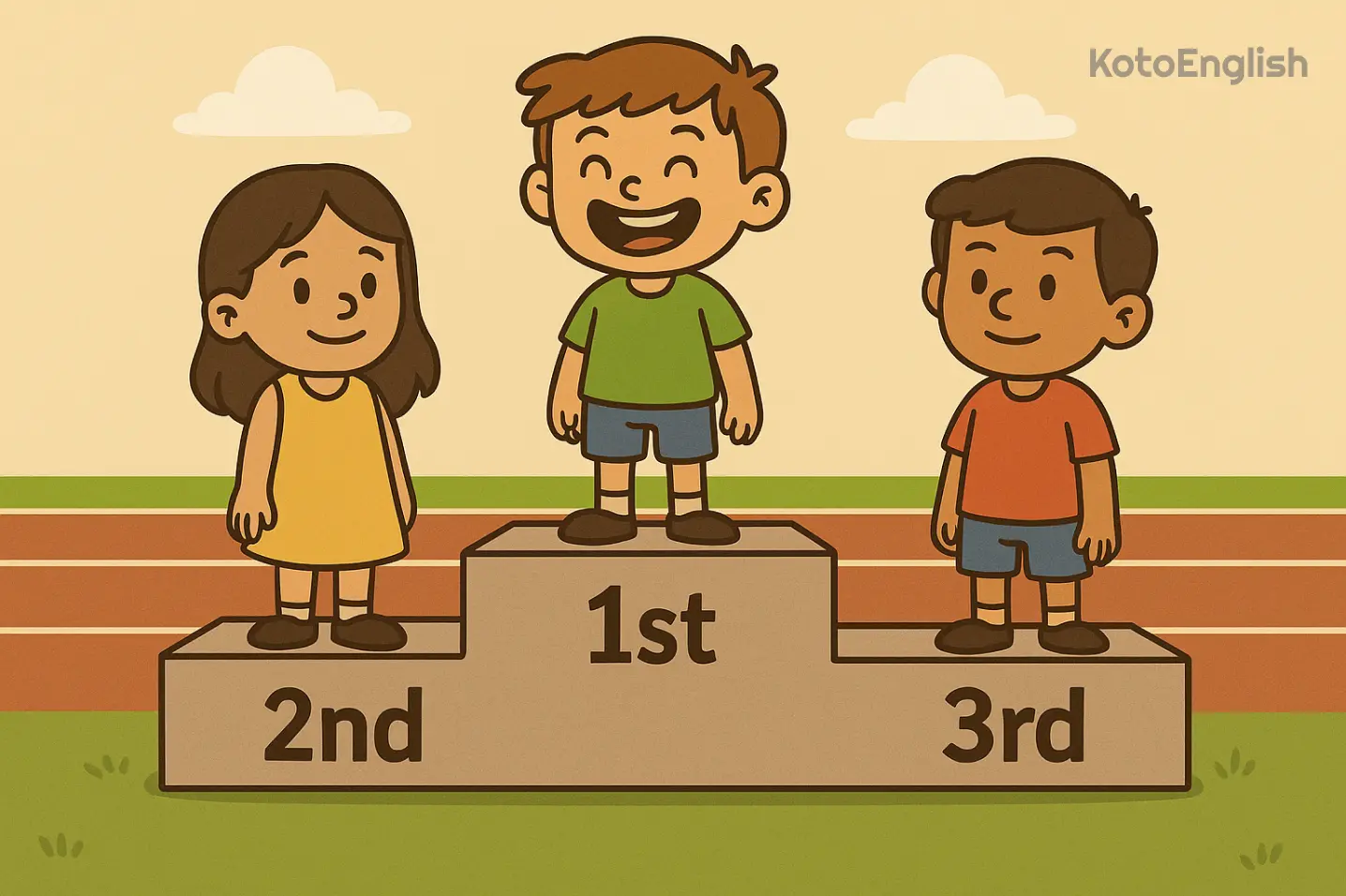
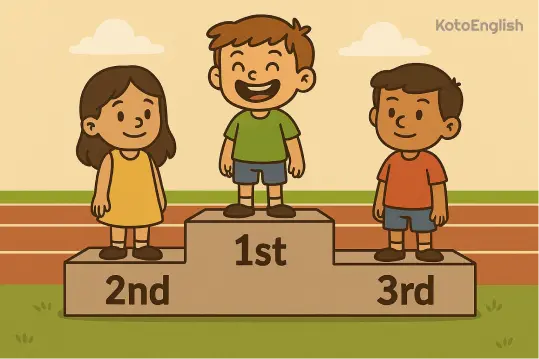
Listen to their pronunciation and read the instances to spot patterns.
| Digit | Word | Examples |
|---|---|---|
| 1st |
first
|
Beyoncé’s
|
| 2nd |
second
|
I’m passing the exam for the
|
| 3rd |
third
|
Do you live on the
|
| 4th |
fourth
|
I am
|
| 5th |
fifth
|
My birthday is on the
|
| 6th |
sixth
|
It’s your
|
| 7th |
seventh
|
The
|
| 8th |
eighth
|
August is the
|
| 9th |
ninth
|
The
|
| 10th |
tenth
|
She was
|
| 11th |
eleventh
|
This is the
|
| 12th |
twelfth
|
This is your
|
| 13th |
thirteenth
|
The castle was built in the
|
| 14th |
fourteenth
|
I am sending my
|
| 15th |
fifteenth
|
Your
|
| 16th |
sixteenth
|
Abraham Lincoln is the
|
| 17th |
seventeenth
|
Our company will celebrate its
|
| 18th |
eighteenth
|
In the
|
| 19th |
nineteenth
|
This is the
|
| 20th |
twentieth
|
Our wedding is on the
|
| 21st |
twenty-first
|
Your hotel room is on the
|
| 22nd |
twenty-second
|
He is in the
|
| 23rd |
twenty-third
|
I am looking for the
|
The distinctions you could notice:
- All numbers maintain the same form; we just need to add several endings like st, nd, rd, or th. You use unique words for 1st (first) and 2nd (second). There are some minor changes.
- Starting from the 21st, you need to change only the last digit, even if the number is
one thousand two hundred thirty-fourth (1,234). - The hyphen (-) between tens and ones is used in both cardinal and ordinal numbers in English.
Don’t forget to use the article the or the adjectives my, your, his and so on with ordinal numbers:
Fractions and decimals
A fraction consists of two numbers. The top one is called the numerator, and the bottom is the denominator. In math, they are presented by digits (5/10, 4/6, 8/16).
Typically, the first number is cardinal (three, four, seven) and the second is ordinal (thirds, eighths, sevenths). The hyphen (–) is between two numbers.
There is a list of common fractions native speakers use in daily life:
-
½ — a half of something.
I have finishedhalf of the book. -
¼ – a quarter.
We have eaten aquarter of the cake. -
¾ – three-quarters.
I’ve donethree-quarters of the tasks.
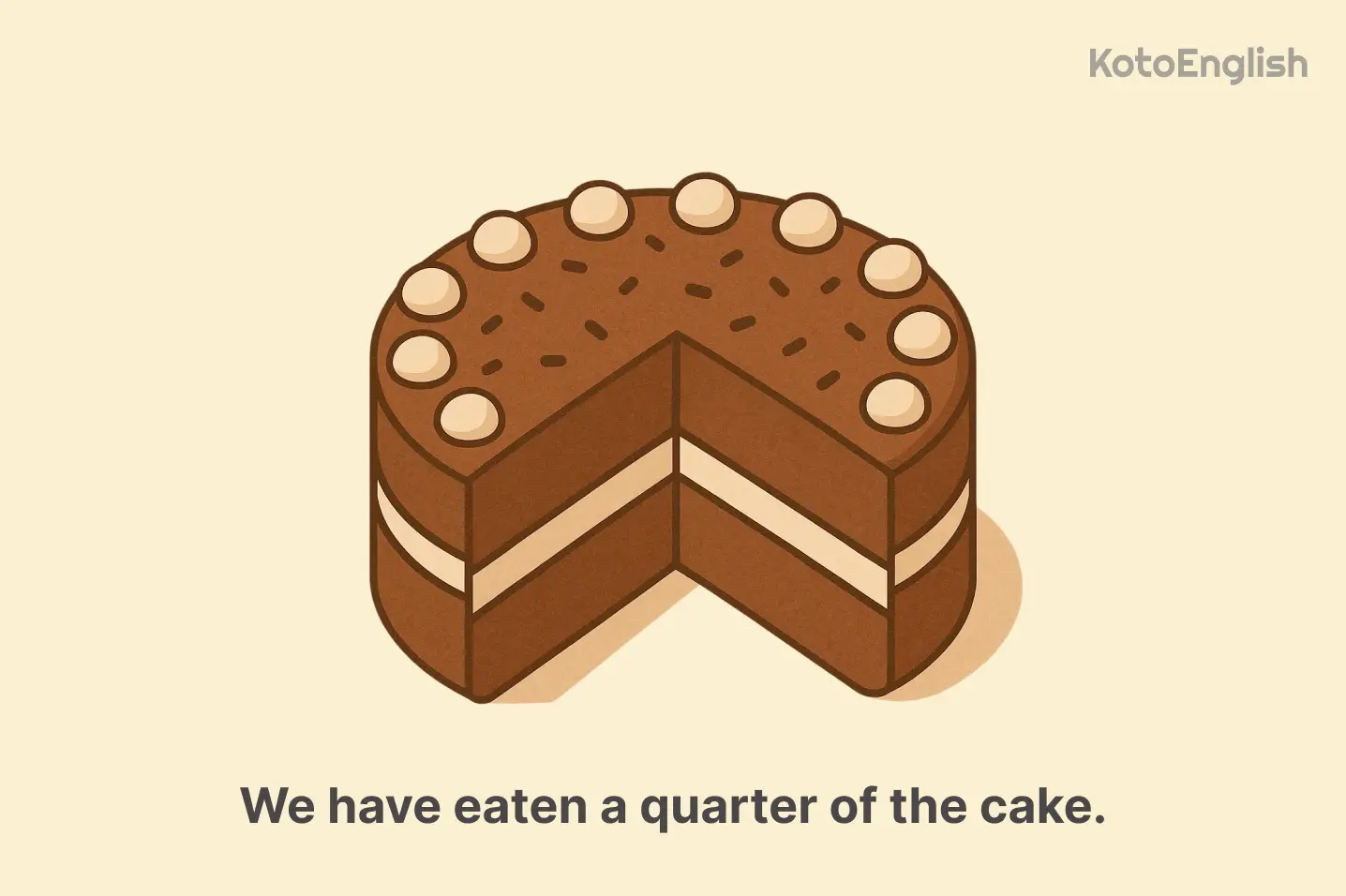
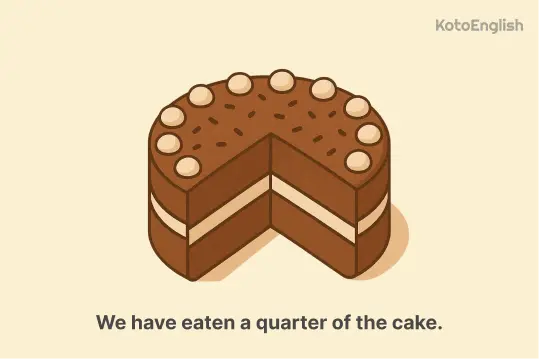
The popular fraction of the Harry Potter series, 9 ¾ in English, is nine and three-quarters.
Decimals are common for statistics, money, and percentages, so it is very important to understand how they are used, because they are significant for confident daily conversations.
Written as digits with a decimal point, these numbers can be both adjectives and nouns. In informal speech, people mostly use fractions.
In the table below, you will find examples of different ways of reading for decimals based on the context. We chose the English number 0.1 to show how reading differs.
| Context | Words | Examples |
|---|---|---|
| Cooking, measurements, math, statistics | one tenth |
Add
|
| Percentage | ten percent |
|
| Screen, tech, labs, science, finance | zero point one |
The interest rate increased by
|
When a number starts with zero, you can omit it. Wanting to say 0.03, you go with point zero three. In this case, people can also say oh instead of zero, so it will be: point oh three.
How to use numbers in sentences?
Daily manipulations with figures sometimes break grammar rules when counting in English. Below, you will find full explanations of how to read dates in English, as well as pronunciation and spelling for time, phone numbers, and prices, which are too specific and can’t be guessed.
How to tell dates in English?
To talk about dates, use ordinals (first, second, third). Based on where you are, you can choose between these two versions:
British:


American:




How to tell time in English?
When someone asks you, What time is it?, you need to follow a simple structure. Begin a sentence with it is, then add the exact hour and minutes.



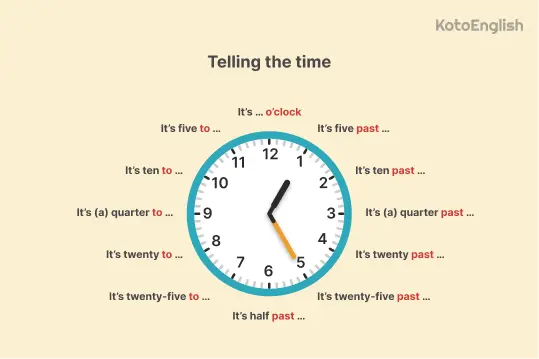
Mandy: Could you tell what time it is?
William: It’s
How to give phone numbers in English?
Thinking of how to pronounce phone numbers, first, you need to choose between British and American formats. Also, there are particular distinctions when you want to deal with an international number.
However, one aspect is the same for each: pronounce each digit separately.
| Format | Digits | Read aloud |
|---|---|---|
| US | (495) 024-3033 |
four nine five, zero two four, three zero three three.
|
| UK | 059 048 0482 |
zero five nine, zero four eight, zero four eight two.
|
| International | +44 948 850 5938 |
plus four four nine four eight five zero five nine three eight.
|
Read the usage example:
Sam: Can I have your number?
Mia: Sure. My phone number is
How to read prices in English?
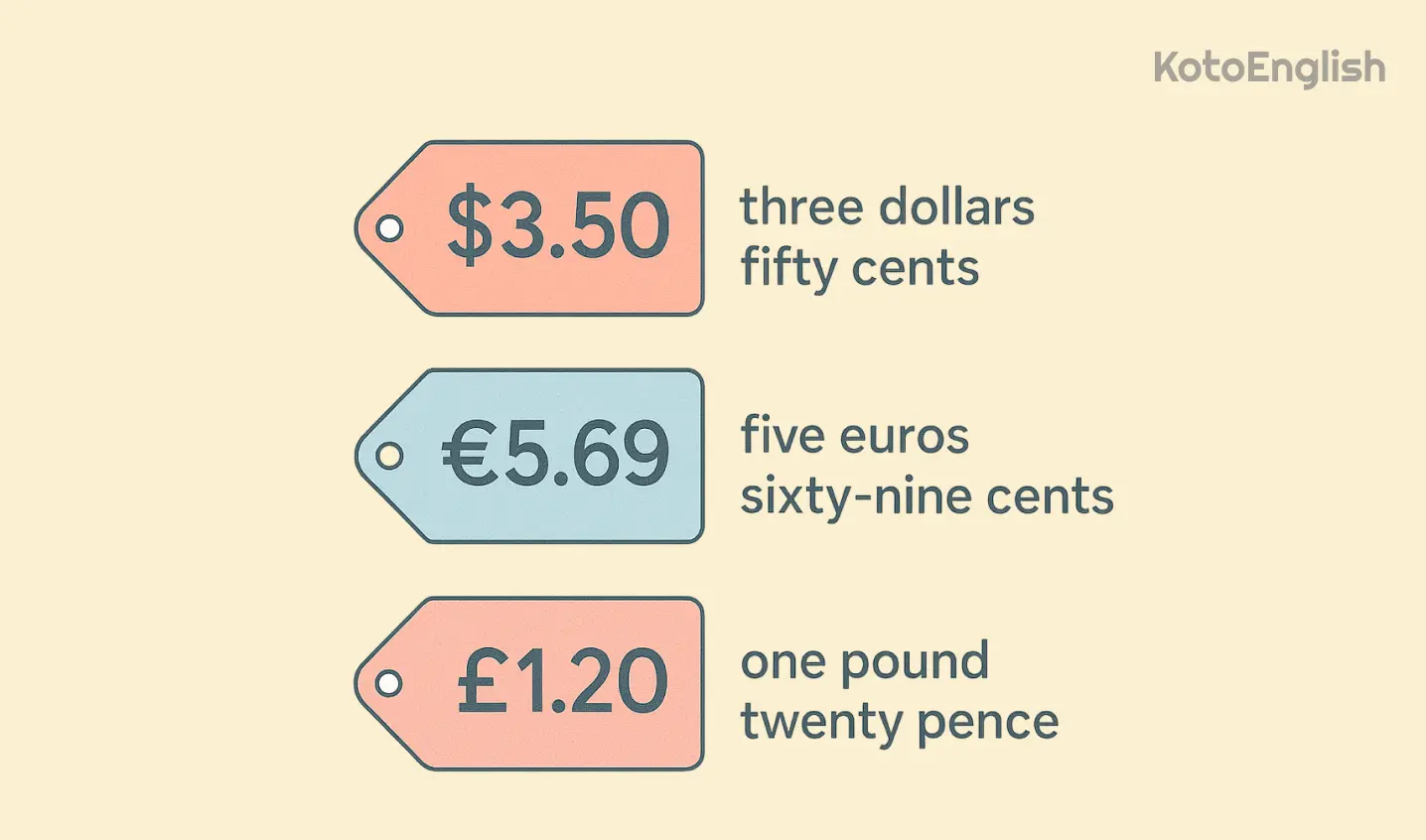
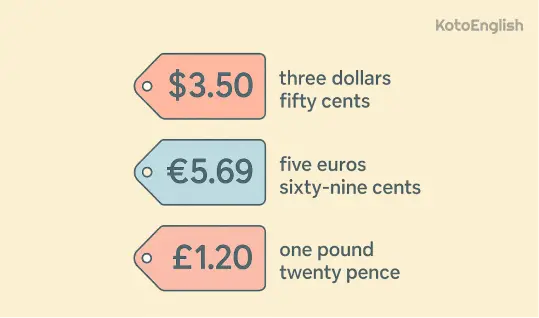
Decimals are used in writing and telling prices, however, without points. In the USA and UK, currency signs are usually placed before the number ($5), while in some other countries, they are positioned after (10$).


Look at the examples and check their pronunciation:
| Digits | Read aloud |
|---|---|
| $3.50 |
|
| €5.69 |
|
| £1.20 |
|
Examples in dialogues:
Luc: How much does this sandwich cost?
Sarah: It’s
Common mistakes
With so many types of information that can be conveyed with numbers in English, from 1 to 100 and beyond, mistakes are unavoidable at the beginning. However, you can limit their occurrence in sentences if you get acquainted with some typical errors.
Confusing thirteen and thirty
These two numbers are similar, except for the ending.
|
There are thirteen days in April.
|
There are thirty days in April.
|
|
Teenagers at the age of thirty are smart.
|
Teenagers at the age of thirteen are smart.
|
Thirteen has stress on the second syllable: thirTEEN, while in thirty it falls on the first part: THIRty.
Forgetting about ordinals’ endings
When writing numbers in English to specify an object’s order, add suitable endings and choose the right forms.
|
My little brother is in the six grade.
|
My little brother is in the sixth grade.
|
|
Look! It is my seven follower.
|
Look! It is my seventh follower.
|
Most ordinal numbers end in th: forth, tenth, hundredth.
Wrong year reading
Sometimes learners misunderstand years, pronouncing them digit by digit or saying the whole number, including thousands and hundreds.
|
My father was born in one thousand nine hundred seventy three.
|
My father was born in nineteen seventy-three.
|
|
Titanic was filmed in one nine nine six.
|
Titanic was filmed in nineteen ninety-six.
|
Group years as two numbers: twenty twenty-five for 2025.
Reading money as decimals
Money indeed belongs to decimals, but it follows special pronunciation rules applied only to it.
|
It’s seven point four five euros.
|
It’s seven euros forty-five.
|
|
Did you see the bill? We paid three hundred point seven nine dollars.
|
Did you see the bill? We paid three hundred dollars seventy-nine cents.
|
Check the explanation in the section Money.
Enjoy personalized learning!
Quick practice quiz
These simple exercises will allow you to check your understanding of the grammar. Pass the test and look at the answers. If you are not sure about the correct option, review its section once more.
Practical tips to learn numbers faster
These small tricks will help you cheat on this layered topic and learn how to operate with all numbers in English quickly.
Tip 1. Create associations
Stories from your life and common phrases from popular culture can help you stick numbers to your memory. It is like when you add a specific meaning to a number, building connections between different words.
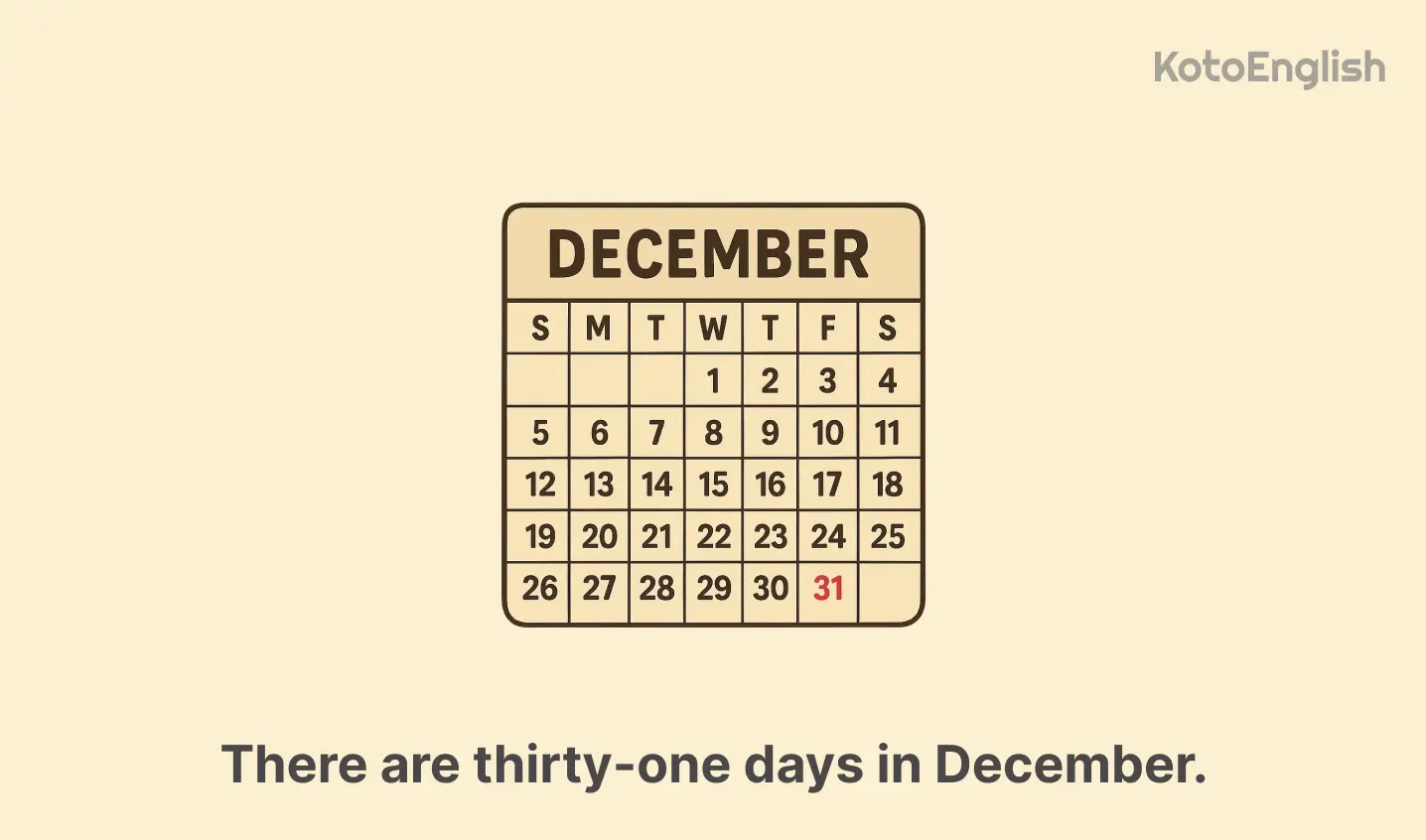
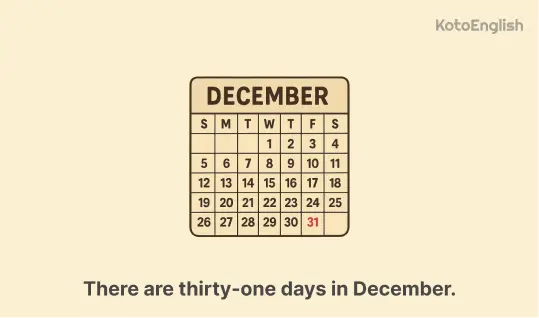
Tip 2. Practice with exercises
Interactive activities make everything faster, from recognizing partners to correcting spelling numbers in English. Applications, such as Koto English, allow you to discover all the nuances of numbers, including those that are not in student books, but are common for native speakers.
Tip 3. Read statistics in English
Grasping more complicated topics, fractions, and decimals will be easier if you listen to real English speech in context and pay attention to how they are used in real life. Then, write your own sentences.
Tip 4. Learn number connections
Reading examples from the tables above, you have probably noticed that there are many similar ways the numbers work. There is no need to learn each number separately, as units repeat in ones, tens and hundreds:
Conclusion
You will learn all the numbers by following a specific sequence. First, make sure that you don’t mess with cardinals and ordinals, and understand how and when to use them. Second, move on to fractions, decimals, and percentages, and practice them with real-life examples.
Learn English on platforms like Koto, which are key to small details that help you grasp rules and advance your knowledge to have natural and worry-free conversations with native speakers.
FAQ about counting and using English numbers
Numbers are words (one, two, three) that have corresponding digits (1, 2, 3). We use them widely in daily communication to count things, show their order, measure them, and talk about time, ages, dates, and prices.
Hundred is used when it means 100 or another number standing before it (two hundred, three hundred, four hundred). The word hundreds is applied when the exact quantity is unknown, approximate or general. For instance, many hundreds of people, there are hundreds of copies.
A clear point separates the two categories of years. Everything that goes before 1999 is pronounced with two two-digit numbers:
With those years that start with 2000, you choose between the pattern two thousand and number:
2025 —
2007 —
Cardinals are the numbers you use to answer the question: How many? Speaking of colleagues at work, of impressions on TikTok, or age, you’ll need to use them, as in the instances below:
Ordinals, the words like first, second, third, tenth, and so on, help you talk about which position a person or an object possesses or its order.
You can improve your skills by counting things in your daily life. Namely, you can count objects that surround you (three chairs, twenty-one books), read prices, dates, phone numbers aloud, and write your lists with a sentence to each number, as it is in our tables.




